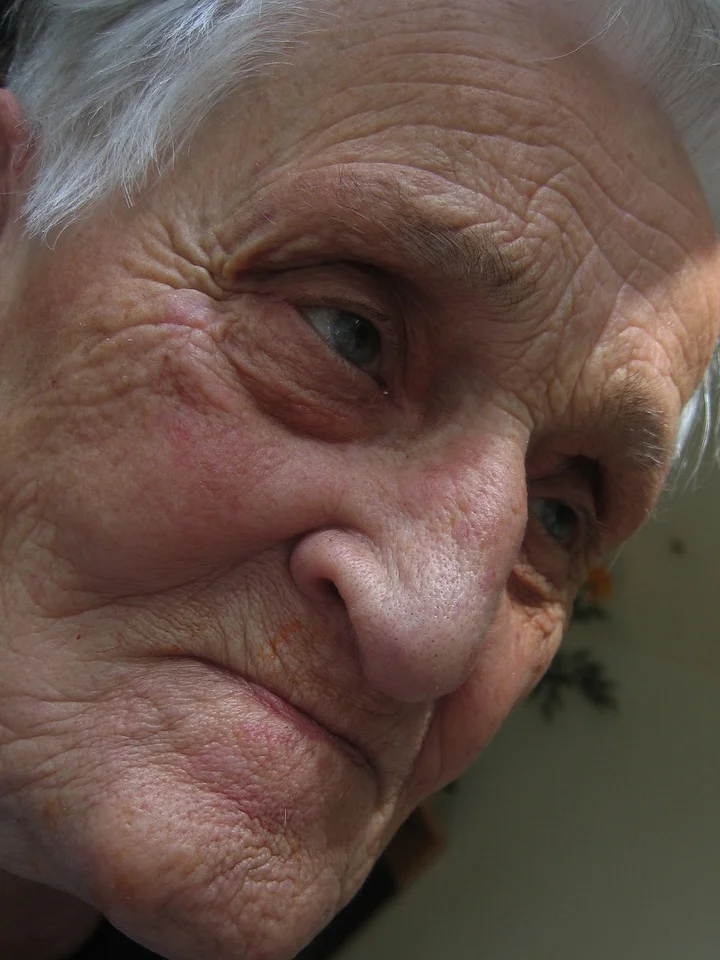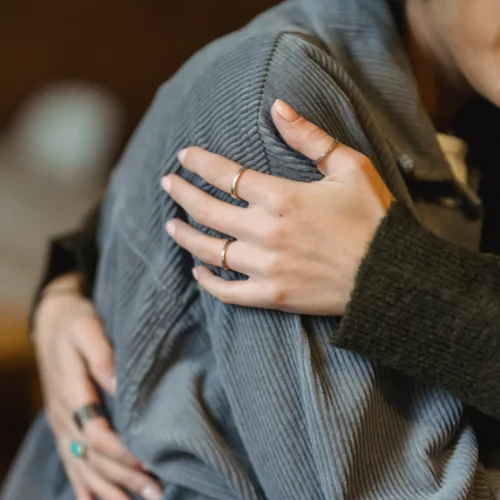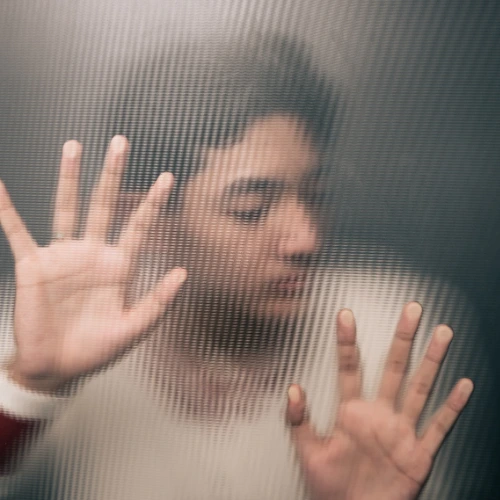Why Does Dementia Make Faces Droop?
Have you ever noticed how a person’s face may seem to droop as they age? It’s a common phenomenon that most of us have seen in our grandparents or elderly relatives. But have you ever wondered why it seems more pronounced in individuals living with dementia? In this blog post, we’ll explore the factors contributing to “dementia face droop”.
Understanding Dementia and Its Impact on Facial Expressions

Dementia is a complex condition that affects millions of people worldwide, including a substantial number of individuals in the United States. It’s not a single disease but rather an umbrella term encompassing various cognitive impairments that interfere with memory, thinking, and daily activities. Alzheimer’s disease, vascular dementia, and Lewy body dementia are just a few examples of conditions falling under the dementia umbrella.
One striking aspect of dementia is its impact on facial expressions. As the condition progresses, you might notice a change in how a person’s face looks and moves. Facial muscles might appear less active or responsive, leading to a drooping appearance. This phenomenon can be particularly noticeable when the person tries to smile or show emotions.
The Science Behind the Droop: Neurological Underpinnings

The root cause of “dementia face droop” lies in the neurological changes that occur in the brain due to the progression of dementia. The brain is a complex organ that controls all our bodily functions, including facial expressions. When dementia sets in, it affects the regions of the brain responsible for controlling these facial muscles, resulting in reduced muscle activity and less mobility in the face.
To put it simply, it’s like the brain’s signals to the facial muscles become weaker or disrupted, leading to a lack of coordination and reduced muscle tone. This, in turn, results in the drooping appearance that we observe.
The Role of Emotional Processing
We all know how our faces change with emotions – a genuine smile lights up the entire face, while sadness can make it appear more somber. Emotional processing is a crucial function of the brain, and it heavily influences how we express ourselves through facial cues.
In individuals with dementia, emotional processing becomes impaired as certain brain areas responsible for processing emotions are affected. As a result, their ability to display emotions through facial expressions diminishes. This can make the face appear less animated and less responsive, adding to the overall droopiness.
Differentiating “Dementia Face Droop” from Other Conditions

Now, you might be wondering, “Isn’t face drooping a symptom of a stroke as well?” You’re right! Facial drooping can indeed be a sign of a stroke, but it’s essential to differentiate between the two scenarios.
In a stroke, face drooping typically occurs suddenly and asymmetrically – one side of the face droops while the other remains normal. On the other hand, “dementia face droop” is more gradual and often affects both sides of the face symmetrically.
Additionally, other stroke symptoms, such as speech difficulties and sudden weakness on one side of the body, are usually absent in dementia-related drooping.
Tips for Communication and Connection
Understanding the reasons behind “dementia face droop” can help us empathize with those experiencing this symptom. It’s crucial to remember that even though their facial expressions might be less expressive, their emotions and feelings are still very much present.
When interacting with individuals living with dementia, consider these tips to foster communication and connection:
1. Eye Contact

Maintain eye contact and observe other non-verbal cues to understand their emotions better.
2. Listening

Focus on actively listening to what they are saying, as communication may not always rely solely on facial expressions.
3. Patience
Be patient and give them time to express themselves. Avoid rushing or completing their sentences for them.
4. Use of Touch

Sometimes, a gentle touch on their hand or shoulder can provide comfort and reassurance.
5. Facial Expressions

Remember to express your emotions through your facial expressions, as this can help set a positive tone for the interaction.
Is “dementia face droop” reversible with treatment or therapy?

Unfortunately, this specific symptom is not reversible through treatment or therapy alone. Dementia is a complex and progressive neurological disorder affecting cognitive and bodily functions. While therapies and treatments may help manage certain aspects of dementia, they do not specifically target facial droop.
For instance, cognitive therapies and medications may improve memory and cognition in some cases, but they do not directly address the muscle weakness responsible for the drooping.
It’s essential to understand that dementia face droop is a physical manifestation of the underlying neurological changes in the brain, and reversing these changes is currently beyond the reach of available medical interventions.
However, managing the symptoms and promoting overall well-being is crucial in enhancing the quality of life for individuals with dementia. Physical therapies and exercises designed to strengthen facial muscles and improve mobility can help maintain the remaining muscle tone, although they might not completely reverse the droop.
Additionally, caregivers and family members need to provide emotional support and create a positive environment for those with dementia. A warm and compassionate approach can help them feel more comfortable and potentially alleviate some stress-related factors that may contribute to facial droop.
Moreover, seeking advice from healthcare professionals, including speech therapists and occupational therapists, can provide valuable guidance in managing the symptoms and improving communication and self-expression.
Does “dementia face droop” affect all types of dementia equally?
Dementia face droop is not equally prevalent across all types of dementia. While facial drooping can be observed in some individuals with dementia, it is not a universal characteristic. The manifestation of facial droop varies depending on the specific type and stage of dementia a person has.
For instance, in Alzheimer’s disease, which is the most common form of dementia in the United States, facial drooping may not be a prominent feature. Alzheimer’s primarily affects memory and cognitive functions, and facial drooping is not typically considered a defining symptom.
On the other hand, certain types of dementia, such as frontotemporal dementia (FTD), may show more pronounced changes in facial expressions. FTD often affects the frontal and temporal lobes of the brain, leading to alterations in behavior, personality, and language. In some cases, this can result in facial muscle weakness or rigidity, leading to noticeable facial droop.
Vascular dementia, another common type in the US, results from impaired blood flow to the brain and can lead to various symptoms depending on the affected areas. In some cases, vascular dementia can affect the nerves controlling facial muscles, leading to facial droop.
Other less common types of dementia, like Lewy body dementia, may also exhibit facial drooping due to its unique impact on both cognitive and motor functions.
It’s important to note that facial drooping in dementia should not be confused with the classic signs of a stroke, where one side of the face droops suddenly due to a blood clot or a burst blood vessel in the brain. Dementia-related facial drooping tends to be more gradual and subtle.
How does “dementia face droop” impact the person’s ability to recognize emotions in others?

Dementia face droop can significantly impact a person’s ability to recognize emotions in others. When someone experiences dementia, their facial muscles may weaken and lose their natural expressiveness. This can result in a reduction of their emotional expressions, making it difficult for others to read their emotions accurately.
For example, if someone with dementia feels sad, their face might not show the usual signs of sadness, such as a downturned mouth or teary eyes. As a result, family members, friends, or caregivers may struggle to understand the person’s emotional state, leading to misinterpretations and potential misunderstandings.
Furthermore, the loss of facial expressiveness in individuals with dementia can hinder their ability to empathize with others. Empathy relies on the ability to recognize and understand the emotions of others through their facial expressions and body language.
When the person with dementia can no longer pick up on these emotional cues due to face drooping, they may have difficulty connecting with others on an emotional level. For instance, they might not notice when a loved one is feeling happy or upset, which can create emotional distance and affect their relationships.
Additionally, the challenges in recognizing emotions can lead to increased frustration and social isolation for individuals with dementia. Imagine a scenario where a person with dementia attends a family gathering.
Without being able to read the emotions on others’ faces, they might feel overwhelmed and disconnected from the group’s dynamics. This could result in them withdrawing from social interactions, as they struggle to engage in meaningful conversations or respond appropriately to others’ emotions.
Moreover, the impact of dementia face droop on recognizing emotions goes beyond social interactions. It can also affect the person’s overall well-being and mental health. Humans are social beings, and our ability to understand and respond to others’ emotions plays a crucial role in our sense of belonging and emotional stability. When individuals with dementia experience difficulties in this area, it can lead to heightened frustration, anxiety, or even depression.
Promoting Empathy and Understanding
“Dementia face droop” may be an observable symptom, but it’s crucial not to jump to conclusions or make assumptions about a person’s mental state based solely on their facial appearance. Each individual’s journey with dementia is unique, and understanding the complexities of the condition can lead to greater empathy and compassion.
Have you encountered “dementia face droop” in your loved ones or interactions? How did you navigate communication and connection? Share your experiences and insights in the comments below. Let’s continue the conversation and learn from each other’s stories.

